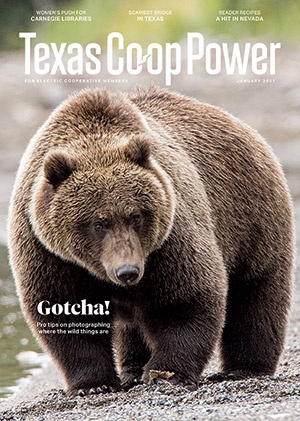Flying Colors
One of the black marks against wind turbines is the number of birds killed by the rotating blades. Black marks, it turns out, could help resolve the problem.
Scientists in Norway found that painting one of the three blades on a wind turbine black reduces avian deaths by 72%.
The paper produced by the Norwegian Institute for Nature Research explains that painting one blade black is believed to create motion smear patterns that birds perceive as moving objects, enabling birds to take evasive action.
Of the more than 60,000 wind turbines in the U.S., Texas has some 15,000—the most of any state.
Tons of Tomatoes
If you love tomatoes, you have about a week left to enter our recipe contest that celebrates the fruit.
Tomatoes are a big deal in Jacksonville.
A big deal. The East Texas city has hundreds of huge concrete tomatoes, some weighing 665 pounds, scattered around town as a declaration of its love for the juicy fruit that many people consider a vegetable.
Uploads of Cash
Parents of K–12 students planned to spend a record $789.49 per family for back-to-school supplies last fall. Purchases of laptops and computer accessories in anticipation of more online schooling because of the COVID-19 pandemic helped break the record set in 2019 by almost $100.
By the Numbers
There are 78 snake species in Texas.
We spotlighted rattlesnakes, one of the most common, in A Snake To Love, April 2020.
25 Years Ago
The Southwest Conference, a sports league that included the major universities in Texas—Baylor, Houston, Rice, Southern Methodist, Texas, Texas A&M, Texas Christian and Texas Tech—disbanded in 1996 after 82 years.
People Flipped Out
The first clamshell cellphone, Motorola’s StarTAC, debuted 25 years ago. It was the smallest and lightest cellphone when it was introduced January 3, 1996.
The StarTAC also was among the first phones to include a display screen and a vibrate alert. Motorola sold 60 million of the devices, which sparked a yearslong flip phone fad.
The Old Three Hundred Hits 200
The Old Three Hundred, the settlers who received land grants in Stephen F. Austin’s first colony, mark their 200th anniversary this month. The government of New Spain, on January 17, 1821, granted Moses Austin a permit to settle 300 families in a part of Mexico that is now Texas.
Moses Austin died before he could fulfill his plans, and his son, Stephen F. Austin, took over. Mexico gained independence from Spain the same year and allowed the younger Austin to proceed with colonization.
Shooting the Moon
American scientists bounced radar waves off the moon for the first time 75 years ago. They sent the signals from the grounds of Fort Monmouth in New Jersey toward the moon as it rose above the horizon. About 2.5 seconds later each time, the signals appeared clearly on an oscilloscope.
This experiment January 10, 1946, marked the birth of radar astronomy, which has been used to map other planets. Historians say it also set the stage for the space race in the U.S.




